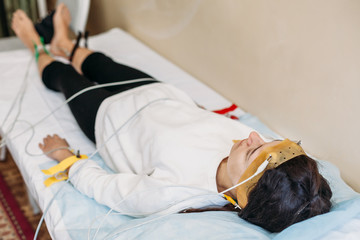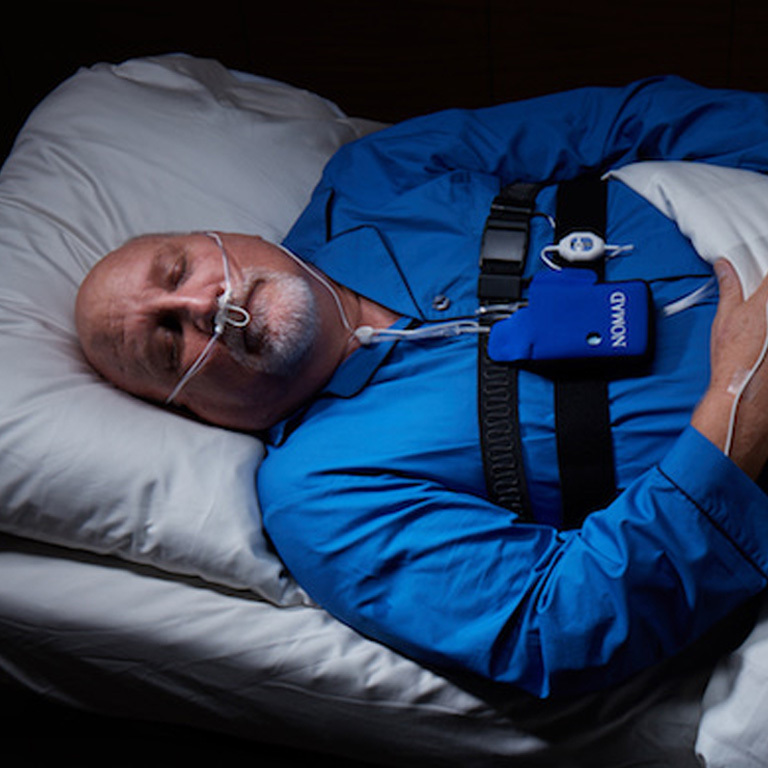Exactly How a Sleep Study Can Change Your Sleep Patterns: Insights and Providers Available
A sleep study offers as an essential tool for individuals seeking to recognize and boost their sleep patterns. It provides a thorough analysis of rest actions and potential conditions. By reviewing various metrics, medical care specialists can recognize underlying concerns that disrupt corrective remainder. This procedure not only aids in medical diagnosis however likewise establishes the phase for customized treatment plans. What insights might a sleep research expose concerning your very own rest routines?
Recognizing Rest Studies: What to Anticipate
When people plan for a sleep research, they usually question what the experience will entail. These researches, usually carried out in a sleep center, purpose to keep an eye on numerous physiological specifications during rest. Upon arrival, individuals are greeted by skilled service technicians who lead them through the process. The atmosphere is made to be comfy, permitting a natural rest experience. Participants might be asked to fill out surveys regarding their sleep behaviors and medical background, which assists in the analysis.
As the evening progresses, sensing units are affixed to the body to track mind waves, heart price, and breathing patterns. While the arrangement may feel uncommon, the goal is to collect precise data on the person's sleep patterns. The entire treatment is non-invasive and poses no risk to the individual. Ultimately, the information collected throughout the rest research is crucial for diagnosing prospective rest disorders and establishing efficient therapy strategies.
Usual Rest Disorders Recognized Via Sleep Researches
Rest studies play a crucial duty in recognizing different rest problems that can significantly influence an individual's health and health. Typical problems found via these studies include obstructive rest apnea, defined by duplicated disruptions in breathing during rest, bring about fragmented sleep patterns. Another widespread condition is sleeplessness, which includes difficulty dropping or staying asleep, often causing daytime exhaustion and damaged performance. Troubled legs disorder (RLS) is also often observed, causing uneasy feelings in the legs and an uncontrollable urge to move them during the night. Narcolepsy, a neurological disorder that affects sleep-wake cycles, is one more major problem determined in sleep researches, leading to excessive daytime drowsiness and unexpected rest assaults. Ultimately, parasomnias, which incorporate uncommon actions throughout sleep, such as sleepwalking or night terrors, are also noted. Early identification of these problems can assist in prompt intervention and enhance overall rest top quality.
The Refine of a Sleep Study: From Prep Work to Outcomes
The procedure of a rest research might appear intimidating, it is a systematic and organized method created to gather important information regarding a person's rest patterns. A healthcare copyright performs a thorough examination, going over rest background and signs with the person. This evaluation helps figure out the details focus of the research study.
Prep work typically includes standards on rest hygiene and medicine modifications before the research. Individuals might be advised to avoid high levels of caffeine and alcohol to assure accurate outcomes. On the evening of the research study, sensing units and electrodes are put to keep an eye on brain activity, heart rate, breathing, and motions throughout sleep.
The data accumulated is meticulously examined by rest specialists, that recognize any type of abnormalities or patterns indicative of rest disorders. Following this analysis, a follow-up examination is set up to go over the searchings for and possible treatment choices tailored to the person's needs, helping with improved sleep quality.

Kinds of Sleep Studies: In-Lab vs. Home Sleep Tests
2 key kinds of rest studies exist: in-lab researches and home rest examinations, each providing to different requirements and scenarios. In-lab researches normally take place in a rest center where individuals are monitored overnight by medical care professionals. This approach enables comprehensive information collection on various sleep parameters, such as brain task, oxygen degrees, and heart rate. People are typically connected to multiple sensors, supplying detailed insights right into their sleep conditions, consisting of rest apnea and narcolepsy.
Conversely, home rest examinations provide a more convenient choice for people who like to perform assessments in their own atmosphere. These mobile devices keep an eye on necessary metrics like air flow, oxygen saturation, and snoring. While home tests are much less comprehensive than in-lab studies, they serve as a useful option for diagnosing typical sleep conditions. Inevitably, the choice in between these 2 types of sleep research studies depends on private choices, medical needs, and the seriousness of sleep-related issues.
Interpreting Your Sleep Research Study Results: Trick Metrics Described
Comprehending the outcomes of a rest study is crucial for individuals seeking understandings right into their sleep health and wellness. Secret metrics typically evaluated in sleep studies consist of the Apnea-Hypopnea Index (AHI), which gauges the variety of apneas and hypopneas per hour of sleep. AHI values assist identify the seriousness of sleep apnea, with greater scores showing much more substantial concerns. An additional important metric is the overall sleep time (TST), which mirrors the general period of rest during the study. Sleep efficiency, the proportion of time spent asleep to time invested in bed, is additionally important; higher portions suggest much better sleep top quality. Furthermore, the percent of sleep spent in various phases-- light, deep, and rapid eye movement-- supplies understandings right into rest architecture. Understanding these metrics gears up clients with the knowledge required to discuss their rest patterns with doctor, paving the method for informed choices concerning their rest health.
Treatment Alternatives and Suggestions Based on Your Rest Research
When a rest study reveals problems such as sleep apnea or other rest conditions, different treatment options and suggestions become offered to enhance overall sleep health. For obstructive sleep apnea, continuous favorable respiratory tract stress (CPAP) treatment is generally suggested, giving a steady stream of air to maintain respiratory tracts open throughout sleep. Dental home appliances may be recommended for moderate to moderate instances, rearranging the jaw to stop airway obstruction.
In cases of sleeplessness, cognitive behavior modification for sleeplessness (CBT-I) is frequently recommended, concentrating on behavior modifications and thought patterns that interfere with rest. Additionally, lifestyle alterations such as weight management, normal exercise, and staying clear of alcohol or caffeine prior to bedtime might improve rest quality.
,aspect=fit)
Structure Healthy Rest Habits: Tips for Better Rest
Building healthy and balanced sleep routines is vital for achieving restorative remainder. Establishing a consistent sleep regimen, restricting display time prior to bed, and creating a comfy rest atmosphere can considerably improve sleep high quality. These approaches act as foundational actions for individuals looking for better rest end results.
Establish a Sleep Routine
Establishing a regular rest routine is necessary for advertising healthy and balanced rest routines and improving total wellness. Sleep Study Bangalore. A routine rest routine, where people go to sleep and wake up at the same time each day, strengthens the body's all-natural body clocks. This predictability helps control the sleep-wake cycle, causing enhanced sleep quality. Producing a soothing pre-sleep routine, such as reading or exercising leisure strategies, can indicate the body that it is time to wind down. In addition, optimizing the sleep environment-- by keeping a comfy temperature, minimizing sound, and making sure darkness-- can additionally sustain relaxing sleep. By prioritizing these practices, people can grow a lasting rest regimen that fosters restorative rest and contributes to better physical and mental health
Restriction Display Time
As individuals significantly rely upon screens for see home entertainment and communication, restricting screen time before bed has actually ended up being necessary for advertising better rest. Study suggests that exposure see this website to blue light given off by tools such as computers, smart devices, and tablet computers can conflict with the manufacturing of melatonin, the hormonal agent in charge of controling sleep. Professionals advise transforming off displays at the very least one hour before going to bed to improve sleep top quality. Taking part in alternative tasks, such as checking out a book or exercising relaxation methods, can help people prepare and unwind for rest. By knowingly minimizing screen time, individuals can cultivate much healthier rest patterns, bring about enhanced general health and raised daytime alertness. Prioritizing this element of rest hygiene is important for long-term wellness.
Produce a Rest Shelter
Producing a sleep sanctuary can substantially improve a person's ability to attain peaceful rest. This atmosphere must prioritize comfort and harmony, integrating aspects that promote leisure. An ideal mattress and cushions are vital, as they directly impact sleep high quality. Furthermore, the area must be dark, quiet, and cool; utilizing blackout curtains and white sound makers can facilitate this environment. Personalizing the space with soothing colors and fragrances, such as lavender, can even more enhance relaxation. Reducing clutter also adds to a serene atmosphere, enabling psychological clearness - Sleep Study Bangalore. By attentively creating a sleep shelter, people can cultivate healthier rest practices and create a constant routine, ultimately bring about enhanced total wellness and restorative rest
Frequently Asked Concerns
How much time Does It Take to See Improvements After a Sleep Research study?
Improvements after a rest research study can differ, but numerous individuals start to discover positive changes within a couple of weeks. Constant follow-up and adherence to advised treatments play crucial duties in attaining perfect results.

Can Kid Undergo Sleep Researches, and Exactly How Are They Various?
Yes, children can go through rest researches, which differ from grown-up research studies in checking methods and equipment. Pediatric analyses frequently involve child-friendly settings and might consist of parent involvement to guarantee comfort and exact results.
Are Rest Studies Covered by Insurance Policy, and What Are the Expenses?
Sleep researches can be covered by insurance coverage, depending upon the policy and clinical requirement. Prices vary extensively, ranging from $300 to $3,000, influenced by the kind of research study and location of the facility.
What Lifestyle Adjustments Can Improve the Efficiency of Rest Study Results?

Applying regular sleep timetables, decreasing caffeine consumption, creating a soothing going to bed routine, and keeping a comfortable sleep atmosphere can substantially boost the performance of sleep research results, advertising better sleep top quality and total health.
How Typically Should I Repeat a Sleep Study for Ongoing Issues?
Individuals experiencing recurring rest issues must consider repeating a rest research study each to 2 years, or as recommended by healthcare experts, to check adjustments and change treatment strategies properly based on their advancing rest patterns. (Sleep Study Bangalore)
Rest studies play a necessary duty in determining various sleep problems that can significantly affect an individual's health and wellness and well-being. Typical problems my response discovered with these studies include obstructive rest apnea, defined by duplicated disruptions in breathing during sleep, leading to fragmented rest patterns. When a rest study discloses concerns such as rest apnea or other sleep disorders, numerous therapy choices and recommendations come to be available to improve overall rest health and wellness. Establishing a consistent rest routine, restricting display time before bed, and developing a comfortable sleep atmosphere can significantly improve rest top quality. Furthermore, maximizing the rest setting-- by maintaining a comfy temperature, reducing noise, and making sure darkness-- can additionally sustain restful sleep.